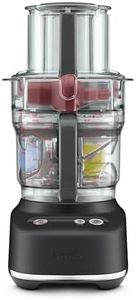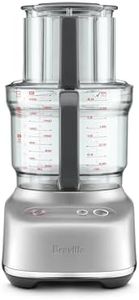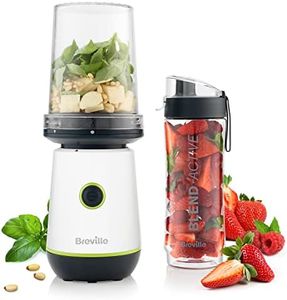We Use CookiesWe use cookies to enhance the security, performance,
functionality and for analytical and promotional activities. By continuing to browse this site you
are agreeing to our privacy policy
6 Best Breville Food Processors
From leading brands and best sellers available on the web.Buying Guide for the Best Breville Food Processors
When you're looking for a food processor, it's important to start by thinking about how you'll use it in your kitchen. Food processors are versatile appliances that can chop, slice, shred, mix, and sometimes even knead dough or puree. Their usefulness depends on their size, power, and the range of attachments and functions they offer. To find the best fit for you, consider the types of recipes you often prepare, how much food you usually make at once, and how much space you have in your kitchen. By understanding the key specifications, you can confidently choose a food processor that matches your needs.Bowl CapacityBowl capacity tells you how much food the processor can handle in one go, usually measured in cups or liters. This is important because a bowl that's too small will require you to work in batches, while an oversized one may be bulky and take up more space. Small capacities (around 3–5 cups) are good for occasional use or tasks like chopping nuts or herbs. Medium sizes (around 8–10 cups) suit most households and let you make larger salads, sauces, or doughs. Large capacities (12 cups or more) are best if you entertain often or prepare meals in bulk. Think about your typical meal prep needs: families or frequent cooks may prefer a larger bowl, while singles or couples might be fine with a smaller size.
Motor PowerMotor power is measured in watts and indicates how powerful the food processor is. More power means it can handle tougher jobs like kneading dough or shredding hard vegetables, and is less likely to struggle or overheat. Lower-powered motors (under 500 watts) work well for light chopping and pureeing. Medium-powered models (500–700 watts) handle most everyday tasks, including slicing and shredding firmer foods. Higher-powered processors (over 700 watts) are ideal for heavy-duty use, such as making bread dough or working with large batches. Choose based on how demanding your usual recipes are: baking enthusiasts or big families should look for higher wattage, while lighter users can go with less.
Attachments and BladesFood processors come with a variety of attachments like different blades, discs, and sometimes dough hooks. These attachments determine how versatile the processor is. Basic models have an S-blade for chopping and mixing, and maybe one or two discs for slicing and shredding. More complex models may include reversible discs, julienne cutters, dough hooks, and even citrus juicers. Think about what tasks you want your food processor to perform: if you just need to chop and slice, a basic set will do; if you want to experiment with more recipes, look for a broader range of attachments. Consider which extras you’ll actually use to avoid paying for functions you don’t need.
Speed Settings and ControlsSpeed settings control how fast the blades spin, and more settings offer better control for different food types and textures. Some food processors have simple, two-speed (low/high) settings, while others offer multiple speeds and a pulse function for even more precision. If you like to fine-tune how you chop or mix your ingredients, look for more speed options. The pulse setting is especially useful for careful chopping and mixing to avoid over-processing. Consider your comfort with controls—simple dials or buttons can be easier, but more speeds add flexibility if you like experimenting with recipes.
Ease of CleaningFood processors can have many parts, and ease of cleaning makes a big difference in how often you'll want to use them. Look for models with dishwasher-safe parts, smooth bowl interiors, and minimal crevices where food could get trapped. If cleaning is quick and easy, you'll be more likely to use your food processor regularly rather than seeing it as a hassle. Think about your routine after cooking: if convenience is a priority, give preference to features that simplify cleaning.
Size and StorageThe overall size of the food processor and the way attachments are stored matter, especially in smaller kitchens. Larger food processors may be harder to fit on the counter or in cupboards, and some have clever storage for all the blades and discs. Compact models are easier to store but might have fewer features. Consider your kitchen space and whether you want to leave the processor out or store it away. Look for models that fit your space and offer convenient, organized storage for accessories.







